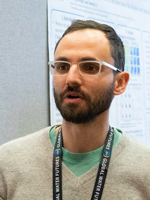
Diogo Costa
Research Scientist- Address
- 1223 11 Innovation Blvd, Saskatoon, SK, S7N 3H5
Background
I am a Research Scientist (RES 2) with the Science and Technology Division of Environment and Climate Change Canada (ECCC) since June 2019. I am based at the National Hydrology Research Centre (NHRC) in Saskatoon. Previously, I was a Research Scientist with the Centre for Hydrology and the Global Institute for Water Security (GIWS) between February and June 2019 under the supervision of John Pomeroy and working in close collaboration with Howard Wheater (U of S), Helen Baulch (U of S), and Jane Elliott (ECCC). This position followed a postdoctoral fellowship within the same institutions and supervision since 2016. At U of S, I also previously held a sessional lecturer appointment in the Fall of 2017 to teach Advanced Hydrology at senior undergraduate and graduate levels. I have previously lectured in the fields of urban hydrology and urban hydraulics. I obtained my Ph.D. from the National University of Singapore (NUS) through the ETH-Zurich research Centre based in Singapore. I hold an MSc from Imperial College London on Hydrology and Water Resources Management and another from the University of Porto, Portugal, on Hydraulic Engineering. I hold a BSc from the University of Porto in “Civil Engineering. My current and previous research are within the Global Water Future (GWF) research program, and I am pursuing a combined experimental-modelling program focused on the development of multi-scale hydro-biogeochemical forecast models suitable for cold regions.
Research Keywords and Interests
- Hydro-biogeochemical modelling
- Hydrodynamic modelling
- Algorithm development
- Biogeochemical processes
- Transport processes in aquatic systems
Areas of expertise
My expertise is in mathematical modelling with a focus on hydro-biogeochemical research. I have specialized in the development of physically-based transport and water quality models for both hydrological and hydrodynamic studies at catchment, stream/lake and groundwater scales. I have a special focus on cold regions processes. Snowmelt, frozen ground and agricultural practices such as tillage and wetland drainage impact hydrochemistry and the runoff of excessive nutrients to Canadian Prairie lakes. Eutrophication of large lakes such as Buffalo Pound and Lake Winnipeg are environmental disasters that result from this runoff. There is great interest in calculating the export of N and P from agricultural fields in the Prairies. However, deficiencies in the representation of cold regions hydrological processes in existing catchment and in-stream water quality models make their application problematic. I am interested in the development of multi-scale models of water quality suitable for cold agricultural regions to improve upon existing models. Since I joined the Centre for Hydrology and GIWS as a postdoctoral research fellow in 2016, I developed several simulation tools that have improved the existing process-based nutrient simulation capabilities in cold regions. I also presented a roadmap for delivering tools to support water quality modelling in the Canadian Prairies. Models that I authored at U of S include (1) WINTRA for simulation of field-scale nitrate response and transport during snowmelt, (2) PULSE for the simulation of snowpack solute dynamics to capture runoff ionic pulses during snowmelt, and (3) stream, depressional storage, soil and snow biogeochemical modules for the Cold Regions Hydrological Model (CRHM). Other models currently under research include (1) PULSE-SMPP, which is an extension of the original PULSE model to 2D and coupling to SMPP (Simulation Model with Preferential flow Paths) for capturing the reallocation and elution of acid solutes in melting snowpacks developing preferential flow, and (2) FLUXOS, which is a hydrodynamic model developed during my PhD, which I am repurposing to simulate snowmelt runoff pathways and the associated transport of nutrients.Although my work at U of S has focused primarily on snow, edge-of-the-field, and catchment simulations, my experience on hydro-biogeochemical system modeling expands to rivers, lakes and estuaries. It comprises both the development and application of several simulation tools. As a Ph.D. student, I developed a modelling framework for high-resolution river-reach scale simulation of contaminant reactive-transport in unsteady river-aquifer systems (FLUXOS). FLUXOS stems from the dynamic, modular coupling of state-of-the-art river and groundwater standalone models of hydrodynamics and water quality (2mb, +QeS2, MODFLOW and MT3D). The model was particularly designed to simulate contaminant propagation during unsteady flow events, such as riverine flooding where the drying and wetting of computational elements/cells require shock-capturing algorithms to guarantee numerical stability. The model was applied to the Ciliwung river-aquifer system in Jakarta, Indonesia, which is widely considered one of the most polluted rivers in the world. During my studies, I also applied models such as WASP for in-stream water quality, MODFLOW and MT3D for respectively groundwater flow and water quality, and Delft3D for flow and water quality in estuaries. Finally, in my MSc studies at Imperial College London I developed the first water quality model for Lake Diefenbaker (Saskatchewan), and in a previous MSc at the University of Oporto and under the AquaStress European Project, I applied a decision support tool (WSM-DSS) for water management in an agricultural, semi-arid region in Portugal.
